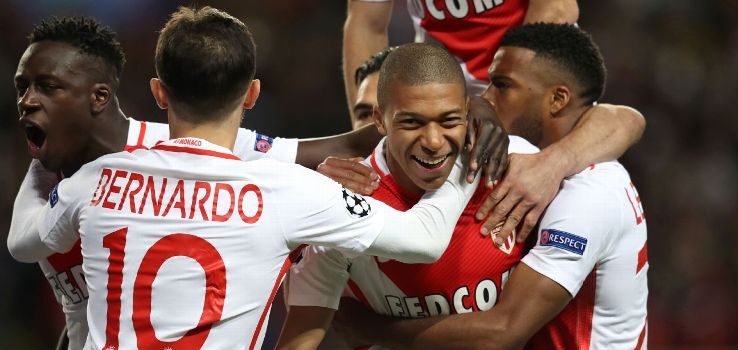Four years ago, AS Monaco wanted to join Europe’s elite.
They just spent two years in the darkness of Ligue 2 and were finally back in France’s top division, Ligue 1.
They were also filthy rich.
Not only did they want to become a Ligue 1 regular and finish top of the table, they wanted to challenge and compete among the best in Europe.
Unhinged spending backfires
The easiest way to achieve this dream of glory was to follow the example set by their league rivals, Paris Saint-Germain. To do so, all Monaco needed to do was to spend, spend, and spend a little bit more.
Hoping it would bring new riches to their dusty trophy cabinet and allow them to become a household name it was once in European football, Monaco understood clearly what to do.
The crazy idea to spend was taken to new heights as they ended up spending close to $160 million in a single transfer window to attract the talents and world class players like James Rodriguez and Radamel Falcao to join in on the experiment—they went mental.
Within the first year of spending the Russian billionaire Dmitry Rybolovlev’s limitless cash, they finished second in Ligue 1 and qualified for the Champions League. It was looking like the right idea and plan going forward.
Many thought they were going to overtake PSG for the Ligue 1 crown in the following seasons.
But the spending started to become a real problem, as return on investment was not there. PSG were still the kings of France and represented France’s best.
Monaco’s smaller market, smaller stadium, and small popularity, was not generating enough revenue to keep up with the model of spend, spend, and spend a little bit more.
Investing in a younger generation of players
Monaco simply scrapped the plan and went into a new direction.
Rather than spend the cash, they invested the cash into the younger generation and made decisions based on turning a profit while winning some silverware.
Many thought the ideas of development went into extinction.
In the simplest of terms, today’s European football is more about buying the best players at every position and hoping it works than establishing a core at the youth levels.
Football is dominated by the rich
Although clubs pour resources into academies, they and we all know the rich clubs can just go buy whomever to fill their needs.
Manchester United bought the most expensive player in the world, Paul Pogba, not even a year ago, and are looking doing the exact same thing this upcoming summer.
The same summer that Manchester United announced Pogba was returning to Old Trafford, Juventus bought Gonzalo Higuain for an Italian football transfer fee.
This year, Real Madrid just spent about $50 million on Brazilian wonderkid Vinicius Junior—who is 16 years old. Manchester City also just signed Monaco’s Bernardo Silva for $55 million.
Along with all those aforementioned transfers, everyone is after Monaco’s 18 year-old Kylian Mbappe who will command more than $100 million. These are just a few examples that come to mind.
Regardless of age, although younger being better, clubs will spend whatever it takes for a player because they simply “need his services.”
Hyperinflation is no doubt part of the reason for the astronomical transfer fees, but there is also a demand—a demand of winning now, which translates to being lazy and hoping buying, or spending the cash, works out successfully on and off the pitch.
And all the big clubs do it.
English giants Chelsea, Arsenal, Manchester United, Manchester City, and soon to be Liverpool do it. French elites PSG and Italian masters Inter Milan, AC Milan, and Juventus do it. German excellence Bayern Munich, and Spanish conquistadors Real Madrid, Barcelona, and yes, Atletico Madrid do it too.
Proving the doubters wrong
However, Monaco proved football’s community of pundits, fans, and the rival clubs themselves wrong. Spend all you want, we can win the other way.
With development and smart spending being the thesis of their proposal to football, not only did Monaco finish above careless spenders PSG, but claimed their first Ligue 1 title in 17 years.
One of the youngest squads assembled in Europe even got to the semi-finals in the Champions League—further than Barcelona, Manchester City, Bayern Munich, and Arsenal. Their operation was a third of the budget of what PSG ran on.
Their brilliance started with scouting players like Fabinho from mid table Rio Ave in Portugal, Kamil Glik from Torino, and Benjamin Mendy from Marseille along with developing a potential all time great Kylian Mbappe.
Risk taking pays off
That’s not all.
According to CNN’s Henry Young, since the 2013/14 spending spree, Monaco’s approach has generated $87 million net transfer profit, while PSG show a $192 million net loss.
Yes Monaco spent the cash for these players, but did not go mental just because they had the cash. They outsmarted the elite sides and built a team like it should.
This is real football, and that’s a win for football.
A sight for sore eyes
The big spending by clubs is fake. Football has become too predictable. Rich owners buy the best players for absurd prices hoping they win.
If a club can spend all the money in the world, even if UEFA has rules in place to promote fairness, football no longer becomes fun, exciting, and unpredictable.
Elitism continues to be dangerous to the world’s most beautiful game.
Like Leicester City last season, Monaco are a breath of fresh air and a sight for sore eyes.
Written by Steven Jotterand
Follow Steven on Twitter @StevenJotterand
Like O-Posts on Facebook
You can also follow O-Posts on Twitter @OPosts

